Inclusion and Exclusion in Education: Case Study Analysis
VerifiedAdded on 2021/12/14
|17
|4761
|204
Essay
AI Summary
This essay delves into the multifaceted issues of inclusion and exclusion within educational settings. It begins by defining the importance of schools and education systems, highlighting their role in shaping students' professional and personal lives. The essay then transitions to address the challenges of bullying and exclusion, particularly affecting vulnerable groups like immigrants, students with disabilities, and those facing discrimination. It categorizes exclusion into lawful and unlawful types, detailing internal and social exclusion. A case study of Eastfield Secondary School is presented, focusing on two students, Jay and Kate, who experience exclusion. The essay identifies these cases as instances of unlawful social exclusion and explores the potential negative impacts on the students' well-being, including physical, emotional, and mental health. The essay emphasizes the need for inclusive practices and strategies to support all students, advocating for a more equitable and supportive educational environment.
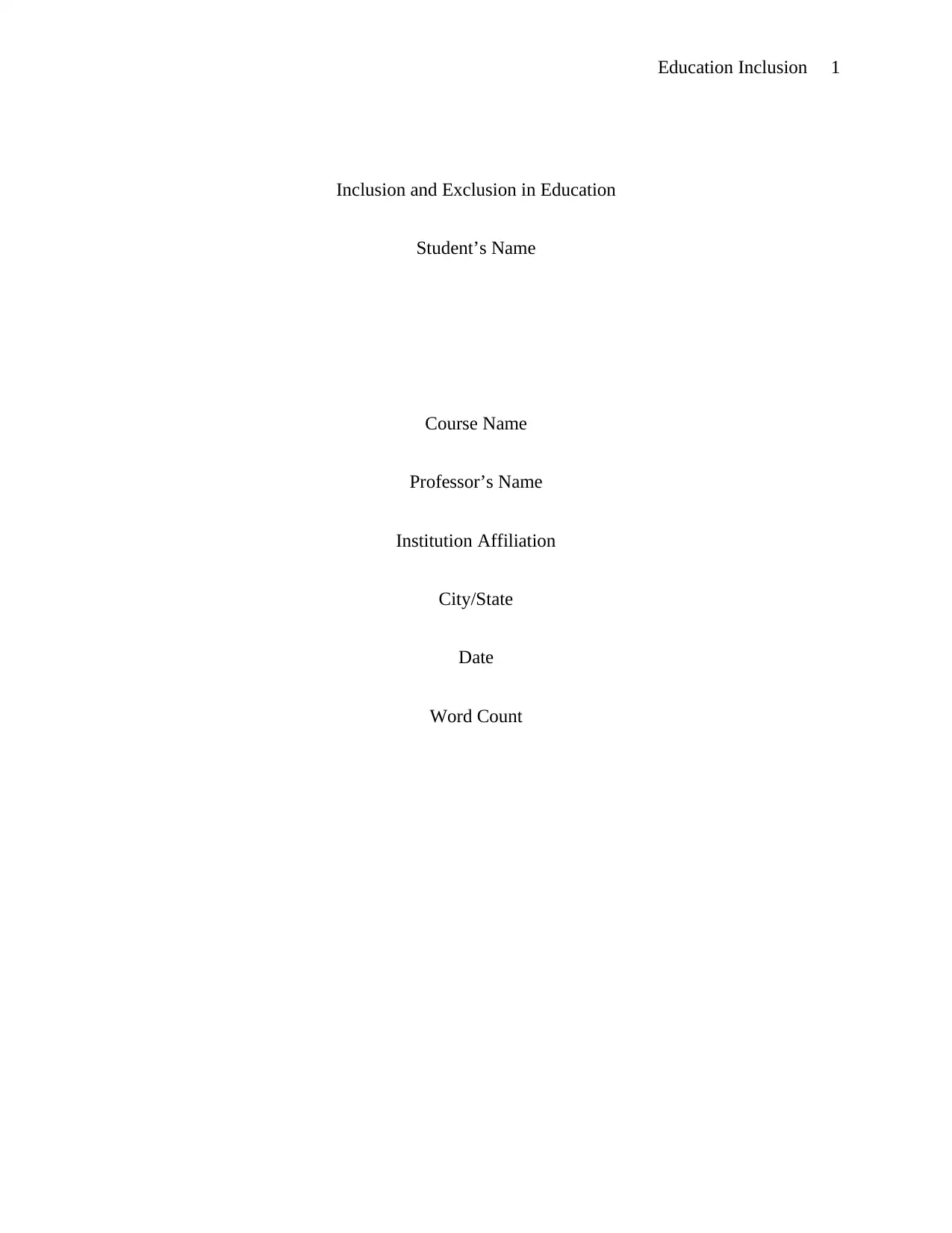
Education Inclusion 1
Inclusion and Exclusion in Education
Student’s Name
Course Name
Professor’s Name
Institution Affiliation
City/State
Date
Word Count
Inclusion and Exclusion in Education
Student’s Name
Course Name
Professor’s Name
Institution Affiliation
City/State
Date
Word Count
Paraphrase This Document
Need a fresh take? Get an instant paraphrase of this document with our AI Paraphraser
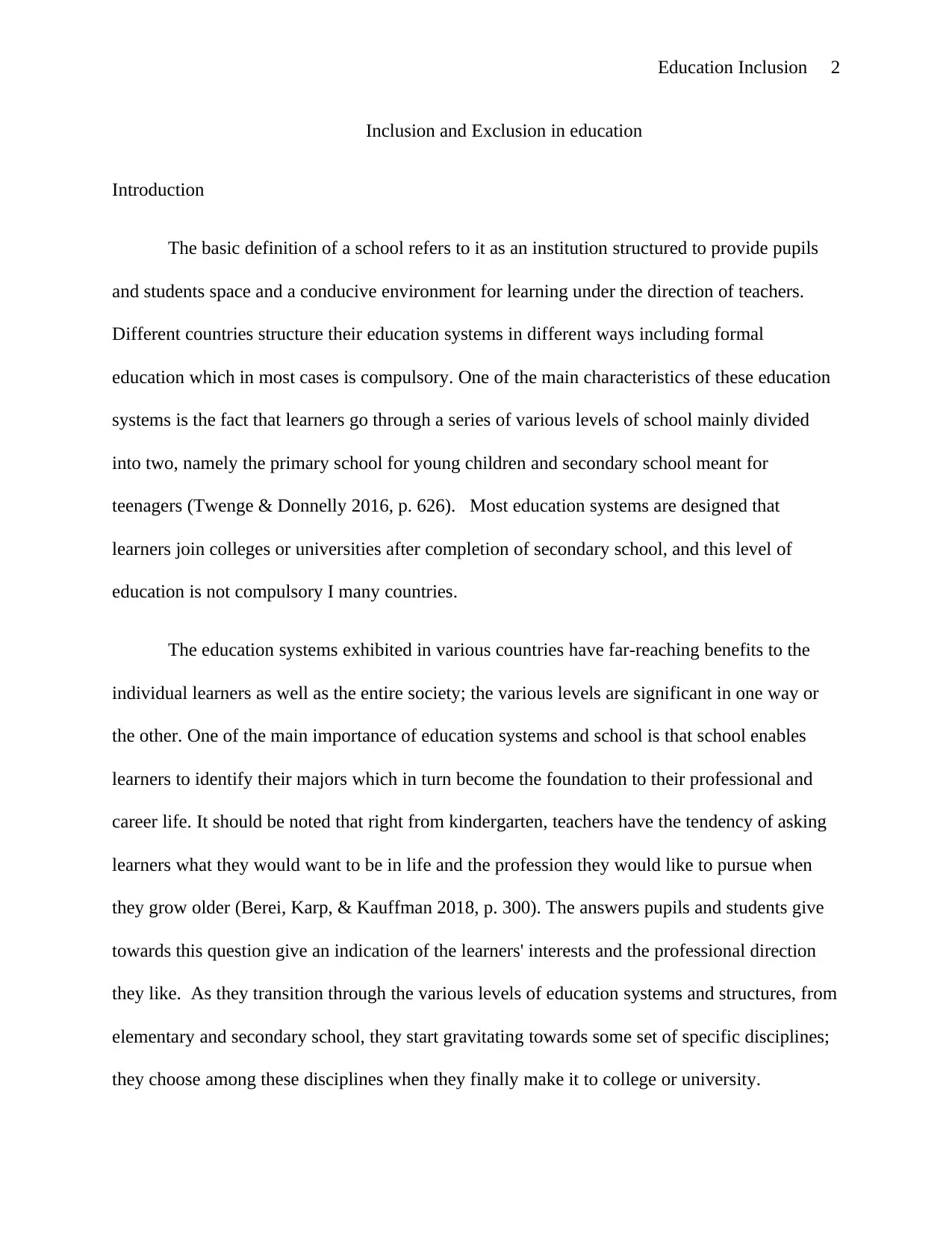
Education Inclusion 2
Inclusion and Exclusion in education
Introduction
The basic definition of a school refers to it as an institution structured to provide pupils
and students space and a conducive environment for learning under the direction of teachers.
Different countries structure their education systems in different ways including formal
education which in most cases is compulsory. One of the main characteristics of these education
systems is the fact that learners go through a series of various levels of school mainly divided
into two, namely the primary school for young children and secondary school meant for
teenagers (Twenge & Donnelly 2016, p. 626). Most education systems are designed that
learners join colleges or universities after completion of secondary school, and this level of
education is not compulsory I many countries.
The education systems exhibited in various countries have far-reaching benefits to the
individual learners as well as the entire society; the various levels are significant in one way or
the other. One of the main importance of education systems and school is that school enables
learners to identify their majors which in turn become the foundation to their professional and
career life. It should be noted that right from kindergarten, teachers have the tendency of asking
learners what they would want to be in life and the profession they would like to pursue when
they grow older (Berei, Karp, & Kauffman 2018, p. 300). The answers pupils and students give
towards this question give an indication of the learners' interests and the professional direction
they like. As they transition through the various levels of education systems and structures, from
elementary and secondary school, they start gravitating towards some set of specific disciplines;
they choose among these disciplines when they finally make it to college or university.
Inclusion and Exclusion in education
Introduction
The basic definition of a school refers to it as an institution structured to provide pupils
and students space and a conducive environment for learning under the direction of teachers.
Different countries structure their education systems in different ways including formal
education which in most cases is compulsory. One of the main characteristics of these education
systems is the fact that learners go through a series of various levels of school mainly divided
into two, namely the primary school for young children and secondary school meant for
teenagers (Twenge & Donnelly 2016, p. 626). Most education systems are designed that
learners join colleges or universities after completion of secondary school, and this level of
education is not compulsory I many countries.
The education systems exhibited in various countries have far-reaching benefits to the
individual learners as well as the entire society; the various levels are significant in one way or
the other. One of the main importance of education systems and school is that school enables
learners to identify their majors which in turn become the foundation to their professional and
career life. It should be noted that right from kindergarten, teachers have the tendency of asking
learners what they would want to be in life and the profession they would like to pursue when
they grow older (Berei, Karp, & Kauffman 2018, p. 300). The answers pupils and students give
towards this question give an indication of the learners' interests and the professional direction
they like. As they transition through the various levels of education systems and structures, from
elementary and secondary school, they start gravitating towards some set of specific disciplines;
they choose among these disciplines when they finally make it to college or university.
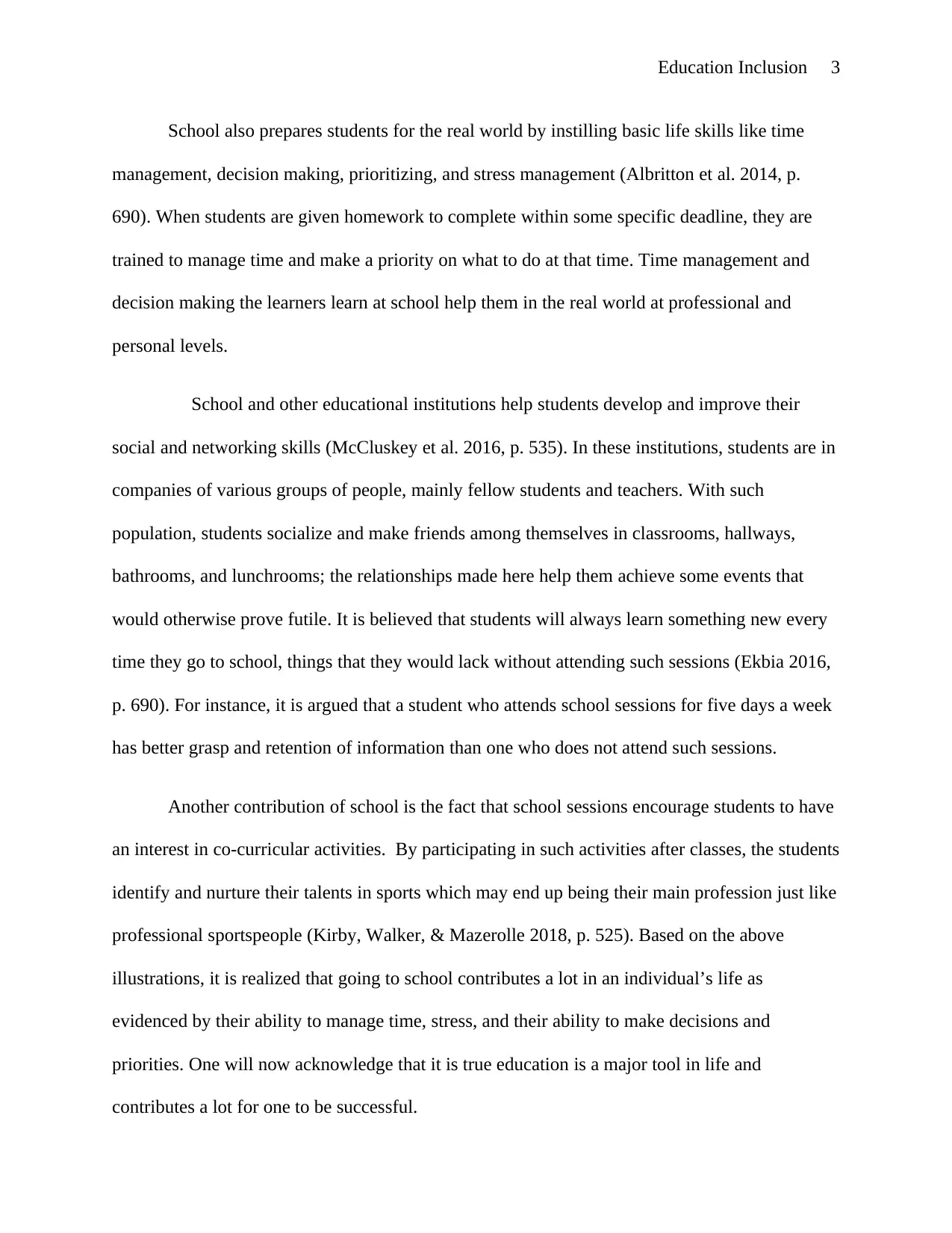
Education Inclusion 3
School also prepares students for the real world by instilling basic life skills like time
management, decision making, prioritizing, and stress management (Albritton et al. 2014, p.
690). When students are given homework to complete within some specific deadline, they are
trained to manage time and make a priority on what to do at that time. Time management and
decision making the learners learn at school help them in the real world at professional and
personal levels.
School and other educational institutions help students develop and improve their
social and networking skills (McCluskey et al. 2016, p. 535). In these institutions, students are in
companies of various groups of people, mainly fellow students and teachers. With such
population, students socialize and make friends among themselves in classrooms, hallways,
bathrooms, and lunchrooms; the relationships made here help them achieve some events that
would otherwise prove futile. It is believed that students will always learn something new every
time they go to school, things that they would lack without attending such sessions (Ekbia 2016,
p. 690). For instance, it is argued that a student who attends school sessions for five days a week
has better grasp and retention of information than one who does not attend such sessions.
Another contribution of school is the fact that school sessions encourage students to have
an interest in co-curricular activities. By participating in such activities after classes, the students
identify and nurture their talents in sports which may end up being their main profession just like
professional sportspeople (Kirby, Walker, & Mazerolle 2018, p. 525). Based on the above
illustrations, it is realized that going to school contributes a lot in an individual’s life as
evidenced by their ability to manage time, stress, and their ability to make decisions and
priorities. One will now acknowledge that it is true education is a major tool in life and
contributes a lot for one to be successful.
School also prepares students for the real world by instilling basic life skills like time
management, decision making, prioritizing, and stress management (Albritton et al. 2014, p.
690). When students are given homework to complete within some specific deadline, they are
trained to manage time and make a priority on what to do at that time. Time management and
decision making the learners learn at school help them in the real world at professional and
personal levels.
School and other educational institutions help students develop and improve their
social and networking skills (McCluskey et al. 2016, p. 535). In these institutions, students are in
companies of various groups of people, mainly fellow students and teachers. With such
population, students socialize and make friends among themselves in classrooms, hallways,
bathrooms, and lunchrooms; the relationships made here help them achieve some events that
would otherwise prove futile. It is believed that students will always learn something new every
time they go to school, things that they would lack without attending such sessions (Ekbia 2016,
p. 690). For instance, it is argued that a student who attends school sessions for five days a week
has better grasp and retention of information than one who does not attend such sessions.
Another contribution of school is the fact that school sessions encourage students to have
an interest in co-curricular activities. By participating in such activities after classes, the students
identify and nurture their talents in sports which may end up being their main profession just like
professional sportspeople (Kirby, Walker, & Mazerolle 2018, p. 525). Based on the above
illustrations, it is realized that going to school contributes a lot in an individual’s life as
evidenced by their ability to manage time, stress, and their ability to make decisions and
priorities. One will now acknowledge that it is true education is a major tool in life and
contributes a lot for one to be successful.
⊘ This is a preview!⊘
Do you want full access?
Subscribe today to unlock all pages.

Trusted by 1+ million students worldwide
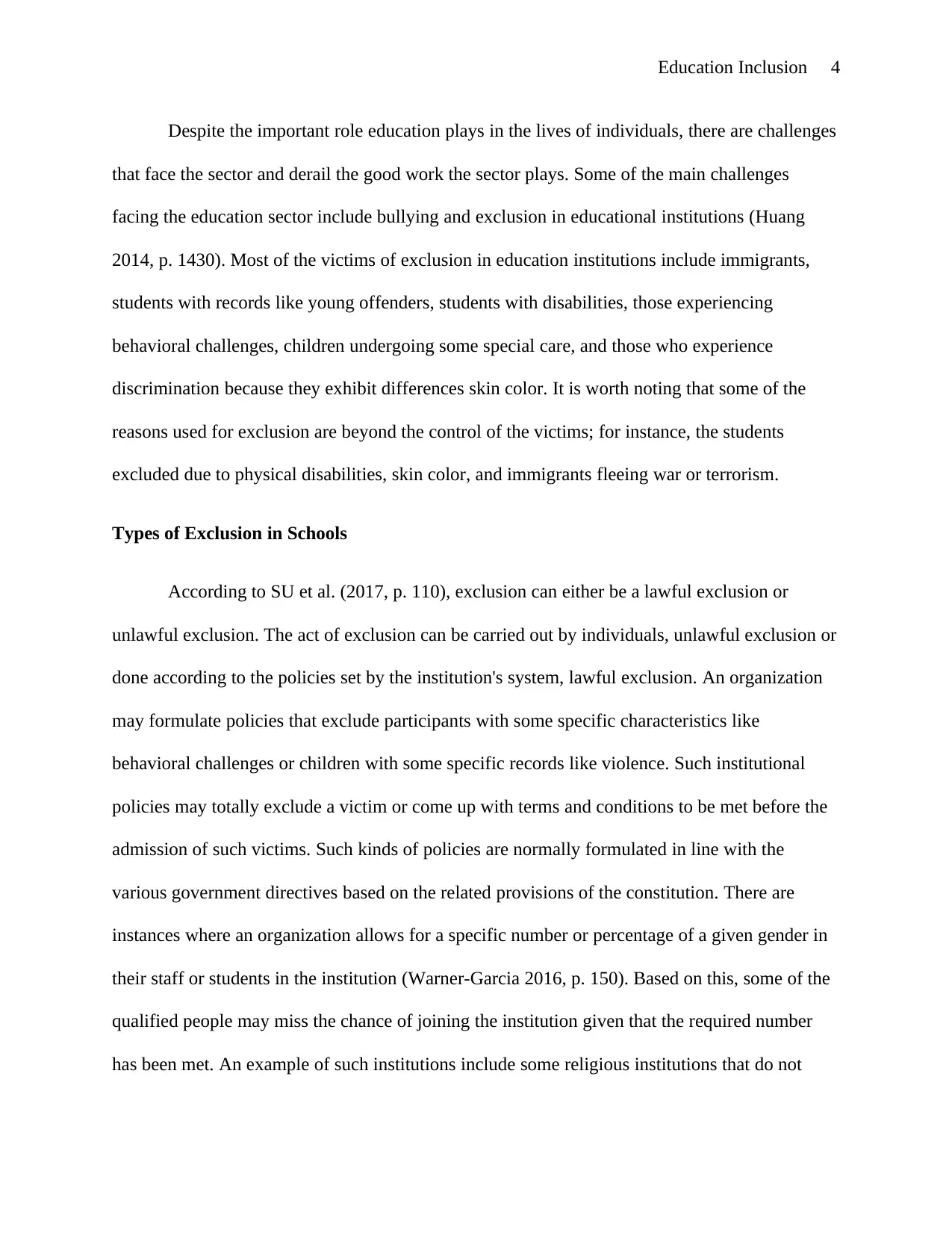
Education Inclusion 4
Despite the important role education plays in the lives of individuals, there are challenges
that face the sector and derail the good work the sector plays. Some of the main challenges
facing the education sector include bullying and exclusion in educational institutions (Huang
2014, p. 1430). Most of the victims of exclusion in education institutions include immigrants,
students with records like young offenders, students with disabilities, those experiencing
behavioral challenges, children undergoing some special care, and those who experience
discrimination because they exhibit differences skin color. It is worth noting that some of the
reasons used for exclusion are beyond the control of the victims; for instance, the students
excluded due to physical disabilities, skin color, and immigrants fleeing war or terrorism.
Types of Exclusion in Schools
According to SU et al. (2017, p. 110), exclusion can either be a lawful exclusion or
unlawful exclusion. The act of exclusion can be carried out by individuals, unlawful exclusion or
done according to the policies set by the institution's system, lawful exclusion. An organization
may formulate policies that exclude participants with some specific characteristics like
behavioral challenges or children with some specific records like violence. Such institutional
policies may totally exclude a victim or come up with terms and conditions to be met before the
admission of such victims. Such kinds of policies are normally formulated in line with the
various government directives based on the related provisions of the constitution. There are
instances where an organization allows for a specific number or percentage of a given gender in
their staff or students in the institution (Warner-Garcia 2016, p. 150). Based on this, some of the
qualified people may miss the chance of joining the institution given that the required number
has been met. An example of such institutions include some religious institutions that do not
Despite the important role education plays in the lives of individuals, there are challenges
that face the sector and derail the good work the sector plays. Some of the main challenges
facing the education sector include bullying and exclusion in educational institutions (Huang
2014, p. 1430). Most of the victims of exclusion in education institutions include immigrants,
students with records like young offenders, students with disabilities, those experiencing
behavioral challenges, children undergoing some special care, and those who experience
discrimination because they exhibit differences skin color. It is worth noting that some of the
reasons used for exclusion are beyond the control of the victims; for instance, the students
excluded due to physical disabilities, skin color, and immigrants fleeing war or terrorism.
Types of Exclusion in Schools
According to SU et al. (2017, p. 110), exclusion can either be a lawful exclusion or
unlawful exclusion. The act of exclusion can be carried out by individuals, unlawful exclusion or
done according to the policies set by the institution's system, lawful exclusion. An organization
may formulate policies that exclude participants with some specific characteristics like
behavioral challenges or children with some specific records like violence. Such institutional
policies may totally exclude a victim or come up with terms and conditions to be met before the
admission of such victims. Such kinds of policies are normally formulated in line with the
various government directives based on the related provisions of the constitution. There are
instances where an organization allows for a specific number or percentage of a given gender in
their staff or students in the institution (Warner-Garcia 2016, p. 150). Based on this, some of the
qualified people may miss the chance of joining the institution given that the required number
has been met. An example of such institutions include some religious institutions that do not
Paraphrase This Document
Need a fresh take? Get an instant paraphrase of this document with our AI Paraphraser
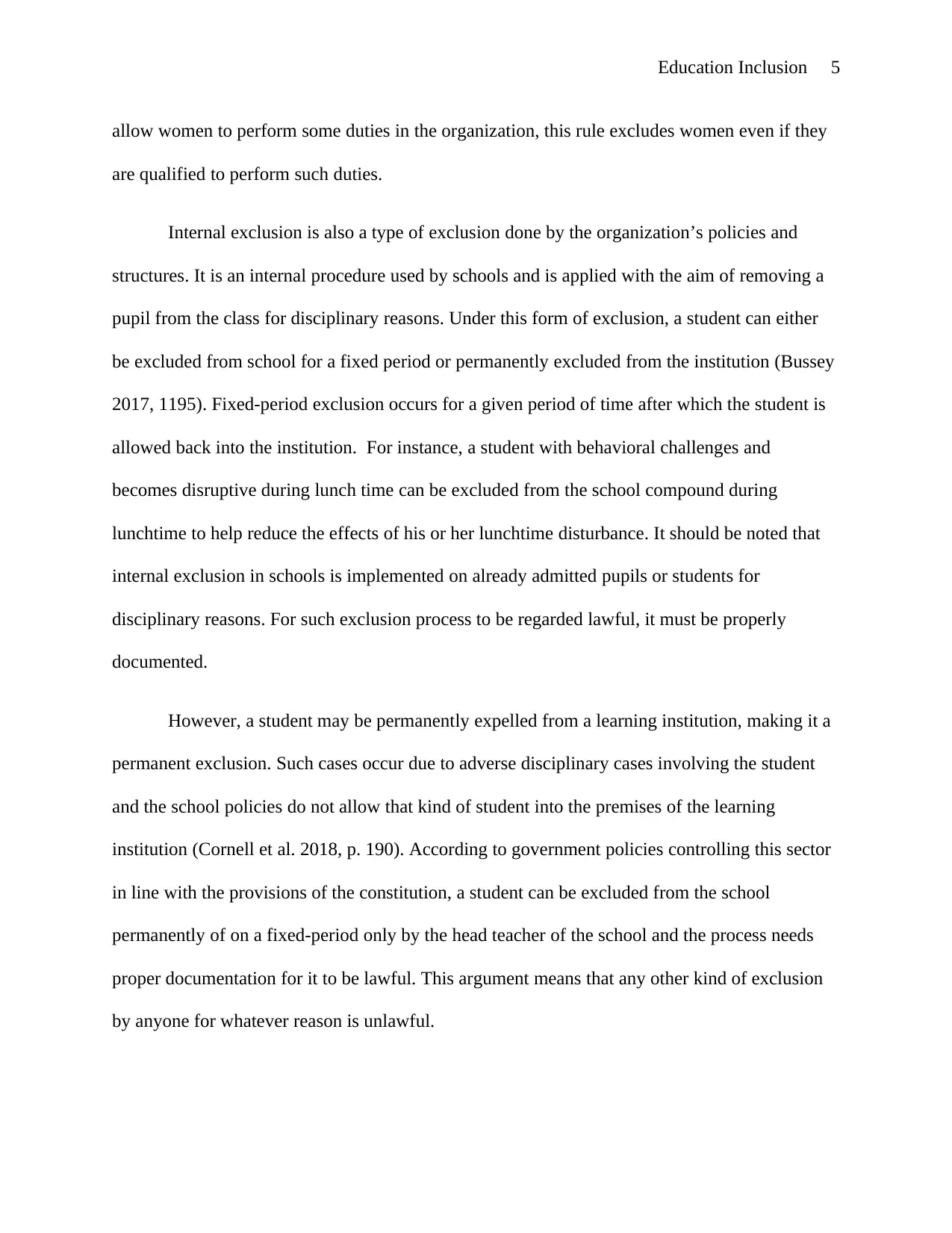
Education Inclusion 5
allow women to perform some duties in the organization, this rule excludes women even if they
are qualified to perform such duties.
Internal exclusion is also a type of exclusion done by the organization’s policies and
structures. It is an internal procedure used by schools and is applied with the aim of removing a
pupil from the class for disciplinary reasons. Under this form of exclusion, a student can either
be excluded from school for a fixed period or permanently excluded from the institution (Bussey
2017, 1195). Fixed-period exclusion occurs for a given period of time after which the student is
allowed back into the institution. For instance, a student with behavioral challenges and
becomes disruptive during lunch time can be excluded from the school compound during
lunchtime to help reduce the effects of his or her lunchtime disturbance. It should be noted that
internal exclusion in schools is implemented on already admitted pupils or students for
disciplinary reasons. For such exclusion process to be regarded lawful, it must be properly
documented.
However, a student may be permanently expelled from a learning institution, making it a
permanent exclusion. Such cases occur due to adverse disciplinary cases involving the student
and the school policies do not allow that kind of student into the premises of the learning
institution (Cornell et al. 2018, p. 190). According to government policies controlling this sector
in line with the provisions of the constitution, a student can be excluded from the school
permanently of on a fixed-period only by the head teacher of the school and the process needs
proper documentation for it to be lawful. This argument means that any other kind of exclusion
by anyone for whatever reason is unlawful.
allow women to perform some duties in the organization, this rule excludes women even if they
are qualified to perform such duties.
Internal exclusion is also a type of exclusion done by the organization’s policies and
structures. It is an internal procedure used by schools and is applied with the aim of removing a
pupil from the class for disciplinary reasons. Under this form of exclusion, a student can either
be excluded from school for a fixed period or permanently excluded from the institution (Bussey
2017, 1195). Fixed-period exclusion occurs for a given period of time after which the student is
allowed back into the institution. For instance, a student with behavioral challenges and
becomes disruptive during lunch time can be excluded from the school compound during
lunchtime to help reduce the effects of his or her lunchtime disturbance. It should be noted that
internal exclusion in schools is implemented on already admitted pupils or students for
disciplinary reasons. For such exclusion process to be regarded lawful, it must be properly
documented.
However, a student may be permanently expelled from a learning institution, making it a
permanent exclusion. Such cases occur due to adverse disciplinary cases involving the student
and the school policies do not allow that kind of student into the premises of the learning
institution (Cornell et al. 2018, p. 190). According to government policies controlling this sector
in line with the provisions of the constitution, a student can be excluded from the school
permanently of on a fixed-period only by the head teacher of the school and the process needs
proper documentation for it to be lawful. This argument means that any other kind of exclusion
by anyone for whatever reason is unlawful.
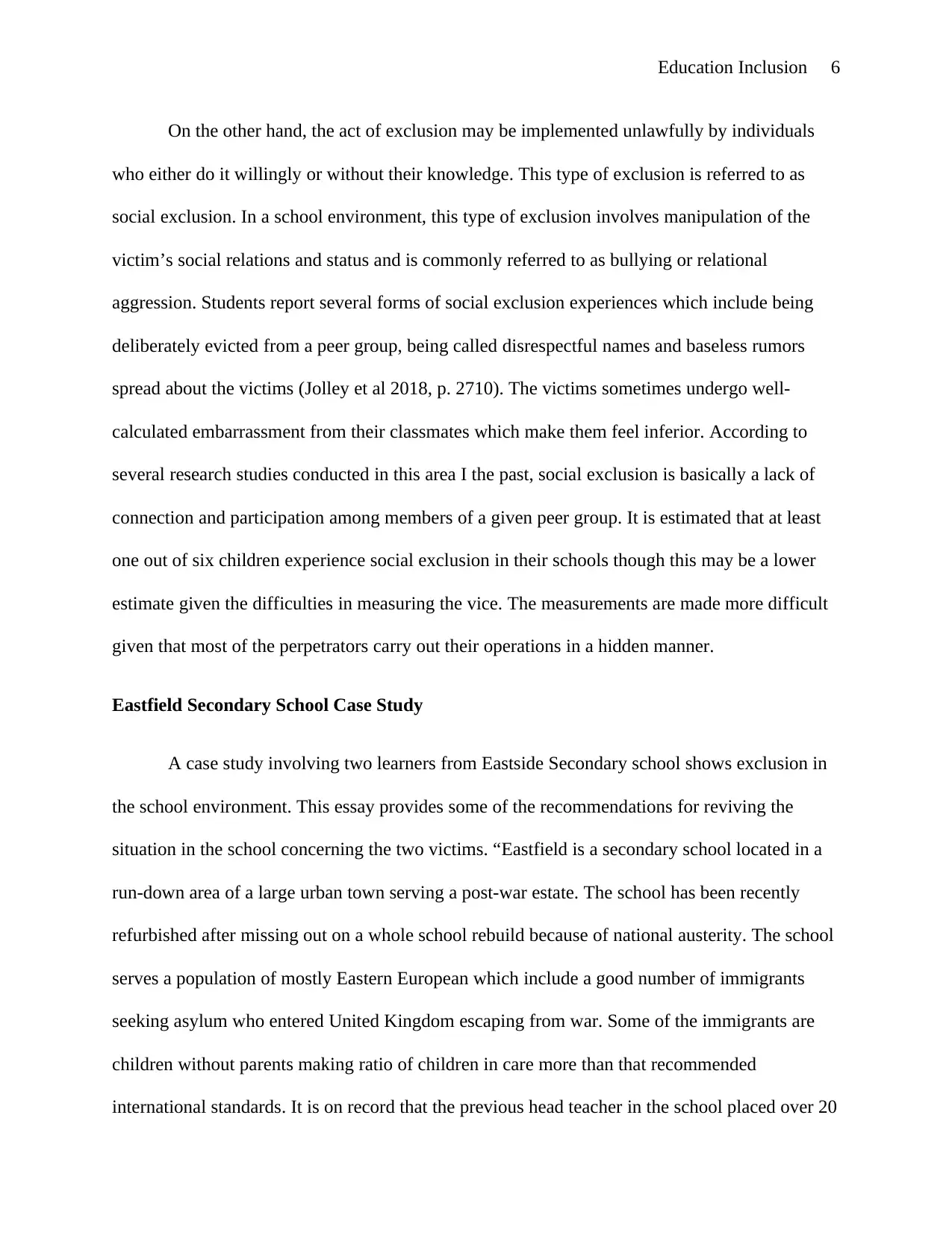
Education Inclusion 6
On the other hand, the act of exclusion may be implemented unlawfully by individuals
who either do it willingly or without their knowledge. This type of exclusion is referred to as
social exclusion. In a school environment, this type of exclusion involves manipulation of the
victim’s social relations and status and is commonly referred to as bullying or relational
aggression. Students report several forms of social exclusion experiences which include being
deliberately evicted from a peer group, being called disrespectful names and baseless rumors
spread about the victims (Jolley et al 2018, p. 2710). The victims sometimes undergo well-
calculated embarrassment from their classmates which make them feel inferior. According to
several research studies conducted in this area I the past, social exclusion is basically a lack of
connection and participation among members of a given peer group. It is estimated that at least
one out of six children experience social exclusion in their schools though this may be a lower
estimate given the difficulties in measuring the vice. The measurements are made more difficult
given that most of the perpetrators carry out their operations in a hidden manner.
Eastfield Secondary School Case Study
A case study involving two learners from Eastside Secondary school shows exclusion in
the school environment. This essay provides some of the recommendations for reviving the
situation in the school concerning the two victims. “Eastfield is a secondary school located in a
run-down area of a large urban town serving a post-war estate. The school has been recently
refurbished after missing out on a whole school rebuild because of national austerity. The school
serves a population of mostly Eastern European which include a good number of immigrants
seeking asylum who entered United Kingdom escaping from war. Some of the immigrants are
children without parents making ratio of children in care more than that recommended
international standards. It is on record that the previous head teacher in the school placed over 20
On the other hand, the act of exclusion may be implemented unlawfully by individuals
who either do it willingly or without their knowledge. This type of exclusion is referred to as
social exclusion. In a school environment, this type of exclusion involves manipulation of the
victim’s social relations and status and is commonly referred to as bullying or relational
aggression. Students report several forms of social exclusion experiences which include being
deliberately evicted from a peer group, being called disrespectful names and baseless rumors
spread about the victims (Jolley et al 2018, p. 2710). The victims sometimes undergo well-
calculated embarrassment from their classmates which make them feel inferior. According to
several research studies conducted in this area I the past, social exclusion is basically a lack of
connection and participation among members of a given peer group. It is estimated that at least
one out of six children experience social exclusion in their schools though this may be a lower
estimate given the difficulties in measuring the vice. The measurements are made more difficult
given that most of the perpetrators carry out their operations in a hidden manner.
Eastfield Secondary School Case Study
A case study involving two learners from Eastside Secondary school shows exclusion in
the school environment. This essay provides some of the recommendations for reviving the
situation in the school concerning the two victims. “Eastfield is a secondary school located in a
run-down area of a large urban town serving a post-war estate. The school has been recently
refurbished after missing out on a whole school rebuild because of national austerity. The school
serves a population of mostly Eastern European which include a good number of immigrants
seeking asylum who entered United Kingdom escaping from war. Some of the immigrants are
children without parents making ratio of children in care more than that recommended
international standards. It is on record that the previous head teacher in the school placed over 20
⊘ This is a preview!⊘
Do you want full access?
Subscribe today to unlock all pages.

Trusted by 1+ million students worldwide
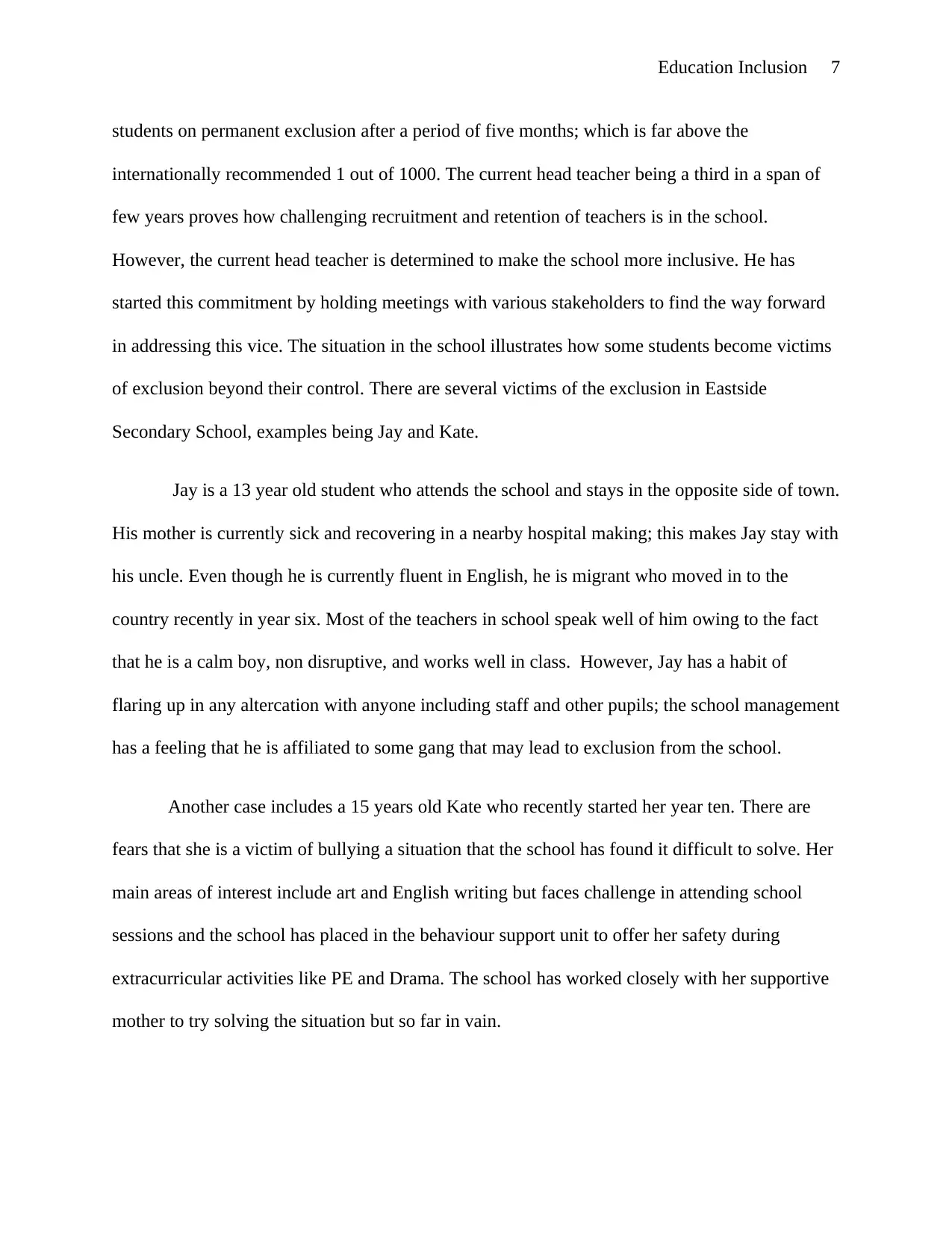
Education Inclusion 7
students on permanent exclusion after a period of five months; which is far above the
internationally recommended 1 out of 1000. The current head teacher being a third in a span of
few years proves how challenging recruitment and retention of teachers is in the school.
However, the current head teacher is determined to make the school more inclusive. He has
started this commitment by holding meetings with various stakeholders to find the way forward
in addressing this vice. The situation in the school illustrates how some students become victims
of exclusion beyond their control. There are several victims of the exclusion in Eastside
Secondary School, examples being Jay and Kate.
Jay is a 13 year old student who attends the school and stays in the opposite side of town.
His mother is currently sick and recovering in a nearby hospital making; this makes Jay stay with
his uncle. Even though he is currently fluent in English, he is migrant who moved in to the
country recently in year six. Most of the teachers in school speak well of him owing to the fact
that he is a calm boy, non disruptive, and works well in class. However, Jay has a habit of
flaring up in any altercation with anyone including staff and other pupils; the school management
has a feeling that he is affiliated to some gang that may lead to exclusion from the school.
Another case includes a 15 years old Kate who recently started her year ten. There are
fears that she is a victim of bullying a situation that the school has found it difficult to solve. Her
main areas of interest include art and English writing but faces challenge in attending school
sessions and the school has placed in the behaviour support unit to offer her safety during
extracurricular activities like PE and Drama. The school has worked closely with her supportive
mother to try solving the situation but so far in vain.
students on permanent exclusion after a period of five months; which is far above the
internationally recommended 1 out of 1000. The current head teacher being a third in a span of
few years proves how challenging recruitment and retention of teachers is in the school.
However, the current head teacher is determined to make the school more inclusive. He has
started this commitment by holding meetings with various stakeholders to find the way forward
in addressing this vice. The situation in the school illustrates how some students become victims
of exclusion beyond their control. There are several victims of the exclusion in Eastside
Secondary School, examples being Jay and Kate.
Jay is a 13 year old student who attends the school and stays in the opposite side of town.
His mother is currently sick and recovering in a nearby hospital making; this makes Jay stay with
his uncle. Even though he is currently fluent in English, he is migrant who moved in to the
country recently in year six. Most of the teachers in school speak well of him owing to the fact
that he is a calm boy, non disruptive, and works well in class. However, Jay has a habit of
flaring up in any altercation with anyone including staff and other pupils; the school management
has a feeling that he is affiliated to some gang that may lead to exclusion from the school.
Another case includes a 15 years old Kate who recently started her year ten. There are
fears that she is a victim of bullying a situation that the school has found it difficult to solve. Her
main areas of interest include art and English writing but faces challenge in attending school
sessions and the school has placed in the behaviour support unit to offer her safety during
extracurricular activities like PE and Drama. The school has worked closely with her supportive
mother to try solving the situation but so far in vain.
Paraphrase This Document
Need a fresh take? Get an instant paraphrase of this document with our AI Paraphraser
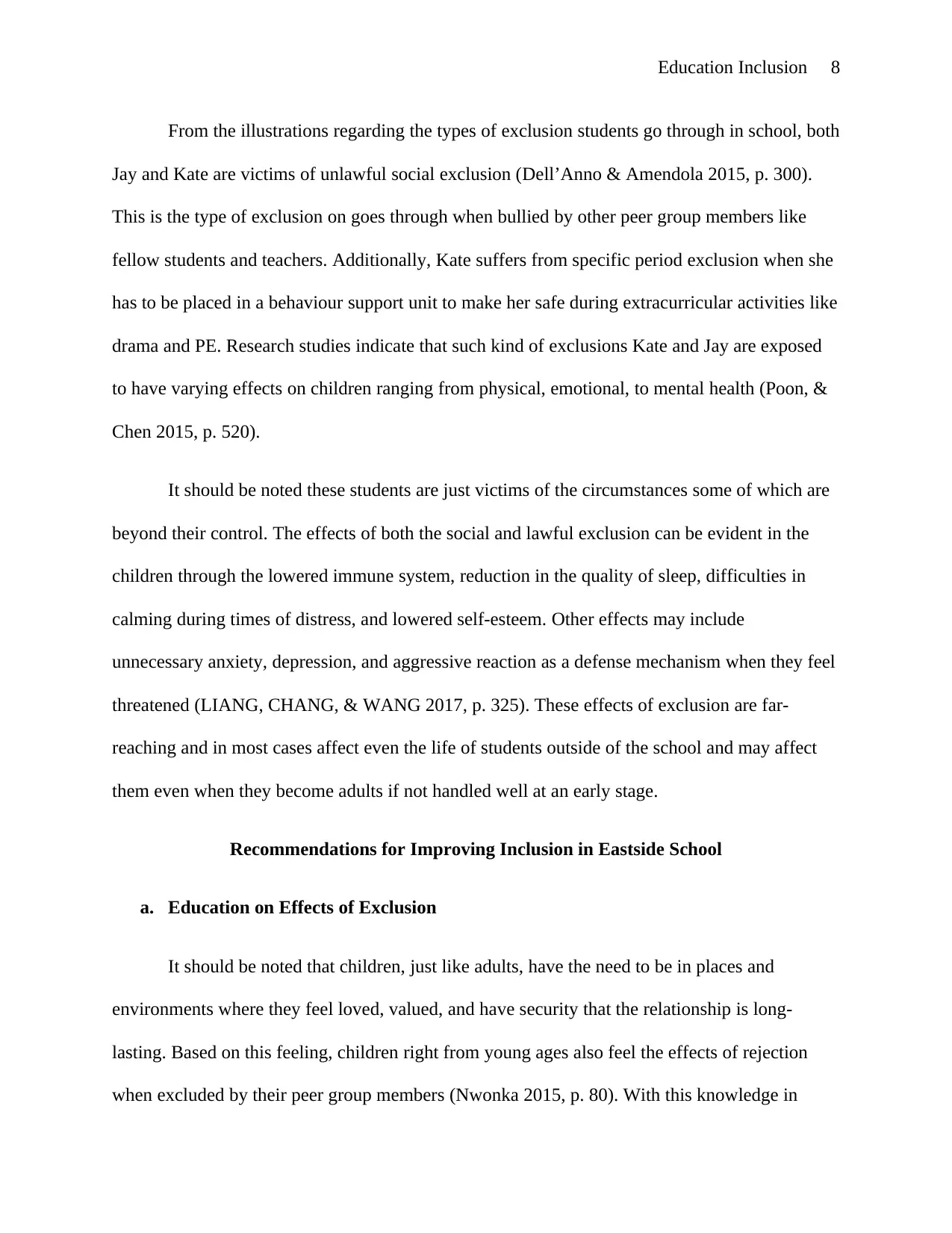
Education Inclusion 8
From the illustrations regarding the types of exclusion students go through in school, both
Jay and Kate are victims of unlawful social exclusion (Dell’Anno & Amendola 2015, p. 300).
This is the type of exclusion on goes through when bullied by other peer group members like
fellow students and teachers. Additionally, Kate suffers from specific period exclusion when she
has to be placed in a behaviour support unit to make her safe during extracurricular activities like
drama and PE. Research studies indicate that such kind of exclusions Kate and Jay are exposed
to have varying effects on children ranging from physical, emotional, to mental health (Poon, &
Chen 2015, p. 520).
It should be noted these students are just victims of the circumstances some of which are
beyond their control. The effects of both the social and lawful exclusion can be evident in the
children through the lowered immune system, reduction in the quality of sleep, difficulties in
calming during times of distress, and lowered self-esteem. Other effects may include
unnecessary anxiety, depression, and aggressive reaction as a defense mechanism when they feel
threatened (LIANG, CHANG, & WANG 2017, p. 325). These effects of exclusion are far-
reaching and in most cases affect even the life of students outside of the school and may affect
them even when they become adults if not handled well at an early stage.
Recommendations for Improving Inclusion in Eastside School
a. Education on Effects of Exclusion
It should be noted that children, just like adults, have the need to be in places and
environments where they feel loved, valued, and have security that the relationship is long-
lasting. Based on this feeling, children right from young ages also feel the effects of rejection
when excluded by their peer group members (Nwonka 2015, p. 80). With this knowledge in
From the illustrations regarding the types of exclusion students go through in school, both
Jay and Kate are victims of unlawful social exclusion (Dell’Anno & Amendola 2015, p. 300).
This is the type of exclusion on goes through when bullied by other peer group members like
fellow students and teachers. Additionally, Kate suffers from specific period exclusion when she
has to be placed in a behaviour support unit to make her safe during extracurricular activities like
drama and PE. Research studies indicate that such kind of exclusions Kate and Jay are exposed
to have varying effects on children ranging from physical, emotional, to mental health (Poon, &
Chen 2015, p. 520).
It should be noted these students are just victims of the circumstances some of which are
beyond their control. The effects of both the social and lawful exclusion can be evident in the
children through the lowered immune system, reduction in the quality of sleep, difficulties in
calming during times of distress, and lowered self-esteem. Other effects may include
unnecessary anxiety, depression, and aggressive reaction as a defense mechanism when they feel
threatened (LIANG, CHANG, & WANG 2017, p. 325). These effects of exclusion are far-
reaching and in most cases affect even the life of students outside of the school and may affect
them even when they become adults if not handled well at an early stage.
Recommendations for Improving Inclusion in Eastside School
a. Education on Effects of Exclusion
It should be noted that children, just like adults, have the need to be in places and
environments where they feel loved, valued, and have security that the relationship is long-
lasting. Based on this feeling, children right from young ages also feel the effects of rejection
when excluded by their peer group members (Nwonka 2015, p. 80). With this knowledge in
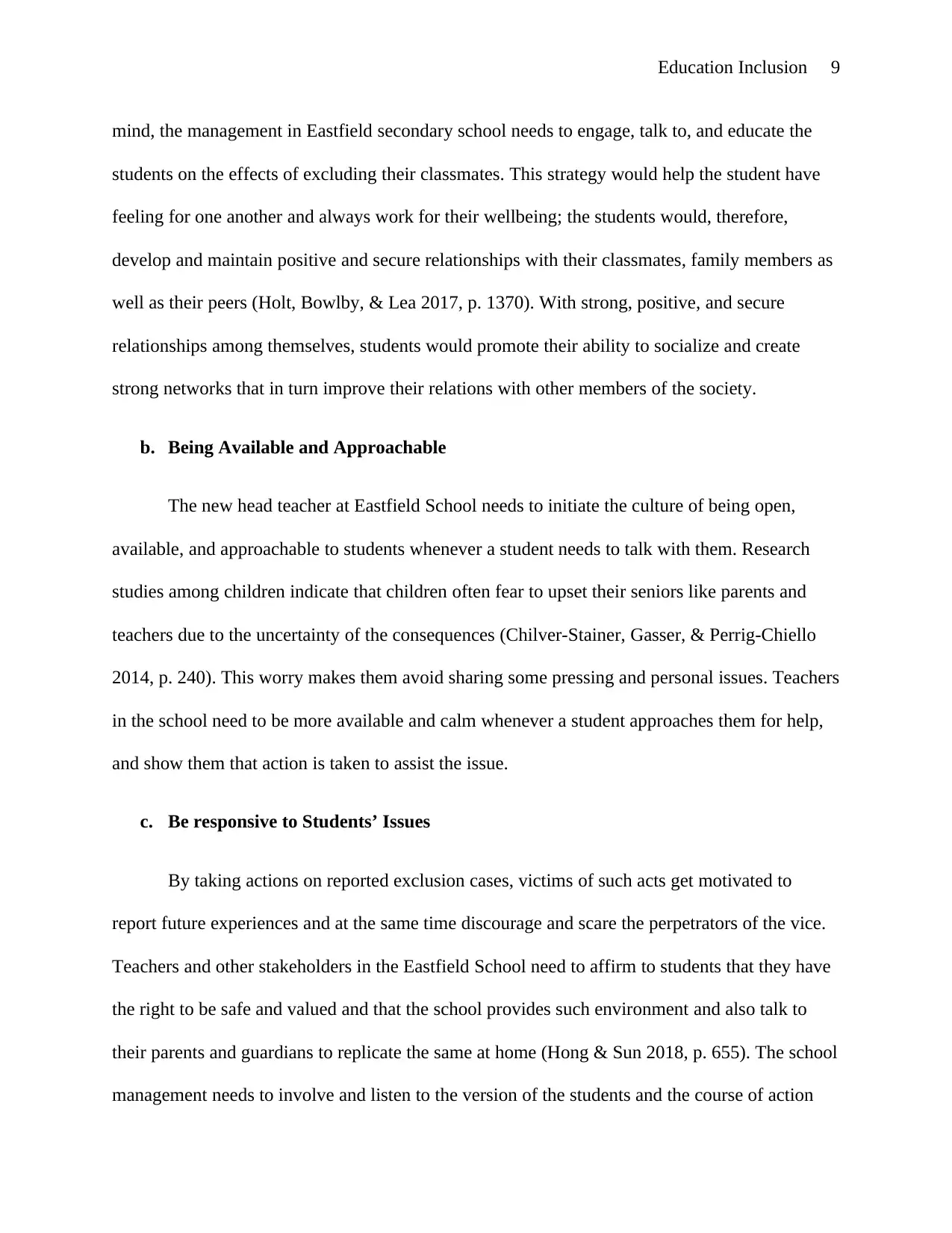
Education Inclusion 9
mind, the management in Eastfield secondary school needs to engage, talk to, and educate the
students on the effects of excluding their classmates. This strategy would help the student have
feeling for one another and always work for their wellbeing; the students would, therefore,
develop and maintain positive and secure relationships with their classmates, family members as
well as their peers (Holt, Bowlby, & Lea 2017, p. 1370). With strong, positive, and secure
relationships among themselves, students would promote their ability to socialize and create
strong networks that in turn improve their relations with other members of the society.
b. Being Available and Approachable
The new head teacher at Eastfield School needs to initiate the culture of being open,
available, and approachable to students whenever a student needs to talk with them. Research
studies among children indicate that children often fear to upset their seniors like parents and
teachers due to the uncertainty of the consequences (Chilver-Stainer, Gasser, & Perrig-Chiello
2014, p. 240). This worry makes them avoid sharing some pressing and personal issues. Teachers
in the school need to be more available and calm whenever a student approaches them for help,
and show them that action is taken to assist the issue.
c. Be responsive to Students’ Issues
By taking actions on reported exclusion cases, victims of such acts get motivated to
report future experiences and at the same time discourage and scare the perpetrators of the vice.
Teachers and other stakeholders in the Eastfield School need to affirm to students that they have
the right to be safe and valued and that the school provides such environment and also talk to
their parents and guardians to replicate the same at home (Hong & Sun 2018, p. 655). The school
management needs to involve and listen to the version of the students and the course of action
mind, the management in Eastfield secondary school needs to engage, talk to, and educate the
students on the effects of excluding their classmates. This strategy would help the student have
feeling for one another and always work for their wellbeing; the students would, therefore,
develop and maintain positive and secure relationships with their classmates, family members as
well as their peers (Holt, Bowlby, & Lea 2017, p. 1370). With strong, positive, and secure
relationships among themselves, students would promote their ability to socialize and create
strong networks that in turn improve their relations with other members of the society.
b. Being Available and Approachable
The new head teacher at Eastfield School needs to initiate the culture of being open,
available, and approachable to students whenever a student needs to talk with them. Research
studies among children indicate that children often fear to upset their seniors like parents and
teachers due to the uncertainty of the consequences (Chilver-Stainer, Gasser, & Perrig-Chiello
2014, p. 240). This worry makes them avoid sharing some pressing and personal issues. Teachers
in the school need to be more available and calm whenever a student approaches them for help,
and show them that action is taken to assist the issue.
c. Be responsive to Students’ Issues
By taking actions on reported exclusion cases, victims of such acts get motivated to
report future experiences and at the same time discourage and scare the perpetrators of the vice.
Teachers and other stakeholders in the Eastfield School need to affirm to students that they have
the right to be safe and valued and that the school provides such environment and also talk to
their parents and guardians to replicate the same at home (Hong & Sun 2018, p. 655). The school
management needs to involve and listen to the version of the students and the course of action
⊘ This is a preview!⊘
Do you want full access?
Subscribe today to unlock all pages.

Trusted by 1+ million students worldwide
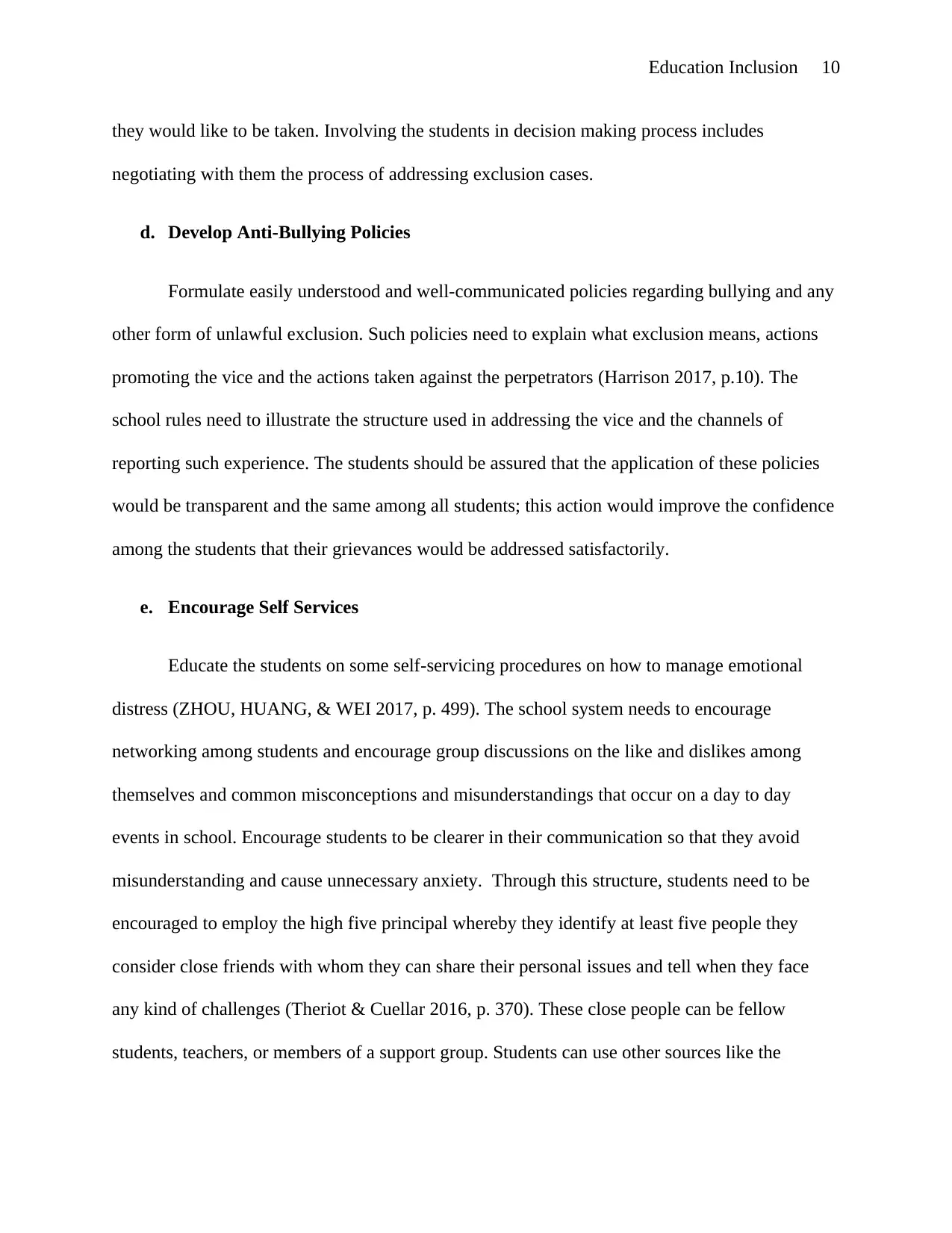
Education Inclusion 10
they would like to be taken. Involving the students in decision making process includes
negotiating with them the process of addressing exclusion cases.
d. Develop Anti-Bullying Policies
Formulate easily understood and well-communicated policies regarding bullying and any
other form of unlawful exclusion. Such policies need to explain what exclusion means, actions
promoting the vice and the actions taken against the perpetrators (Harrison 2017, p.10). The
school rules need to illustrate the structure used in addressing the vice and the channels of
reporting such experience. The students should be assured that the application of these policies
would be transparent and the same among all students; this action would improve the confidence
among the students that their grievances would be addressed satisfactorily.
e. Encourage Self Services
Educate the students on some self-servicing procedures on how to manage emotional
distress (ZHOU, HUANG, & WEI 2017, p. 499). The school system needs to encourage
networking among students and encourage group discussions on the like and dislikes among
themselves and common misconceptions and misunderstandings that occur on a day to day
events in school. Encourage students to be clearer in their communication so that they avoid
misunderstanding and cause unnecessary anxiety. Through this structure, students need to be
encouraged to employ the high five principal whereby they identify at least five people they
consider close friends with whom they can share their personal issues and tell when they face
any kind of challenges (Theriot & Cuellar 2016, p. 370). These close people can be fellow
students, teachers, or members of a support group. Students can use other sources like the
they would like to be taken. Involving the students in decision making process includes
negotiating with them the process of addressing exclusion cases.
d. Develop Anti-Bullying Policies
Formulate easily understood and well-communicated policies regarding bullying and any
other form of unlawful exclusion. Such policies need to explain what exclusion means, actions
promoting the vice and the actions taken against the perpetrators (Harrison 2017, p.10). The
school rules need to illustrate the structure used in addressing the vice and the channels of
reporting such experience. The students should be assured that the application of these policies
would be transparent and the same among all students; this action would improve the confidence
among the students that their grievances would be addressed satisfactorily.
e. Encourage Self Services
Educate the students on some self-servicing procedures on how to manage emotional
distress (ZHOU, HUANG, & WEI 2017, p. 499). The school system needs to encourage
networking among students and encourage group discussions on the like and dislikes among
themselves and common misconceptions and misunderstandings that occur on a day to day
events in school. Encourage students to be clearer in their communication so that they avoid
misunderstanding and cause unnecessary anxiety. Through this structure, students need to be
encouraged to employ the high five principal whereby they identify at least five people they
consider close friends with whom they can share their personal issues and tell when they face
any kind of challenges (Theriot & Cuellar 2016, p. 370). These close people can be fellow
students, teachers, or members of a support group. Students can use other sources like the
Paraphrase This Document
Need a fresh take? Get an instant paraphrase of this document with our AI Paraphraser
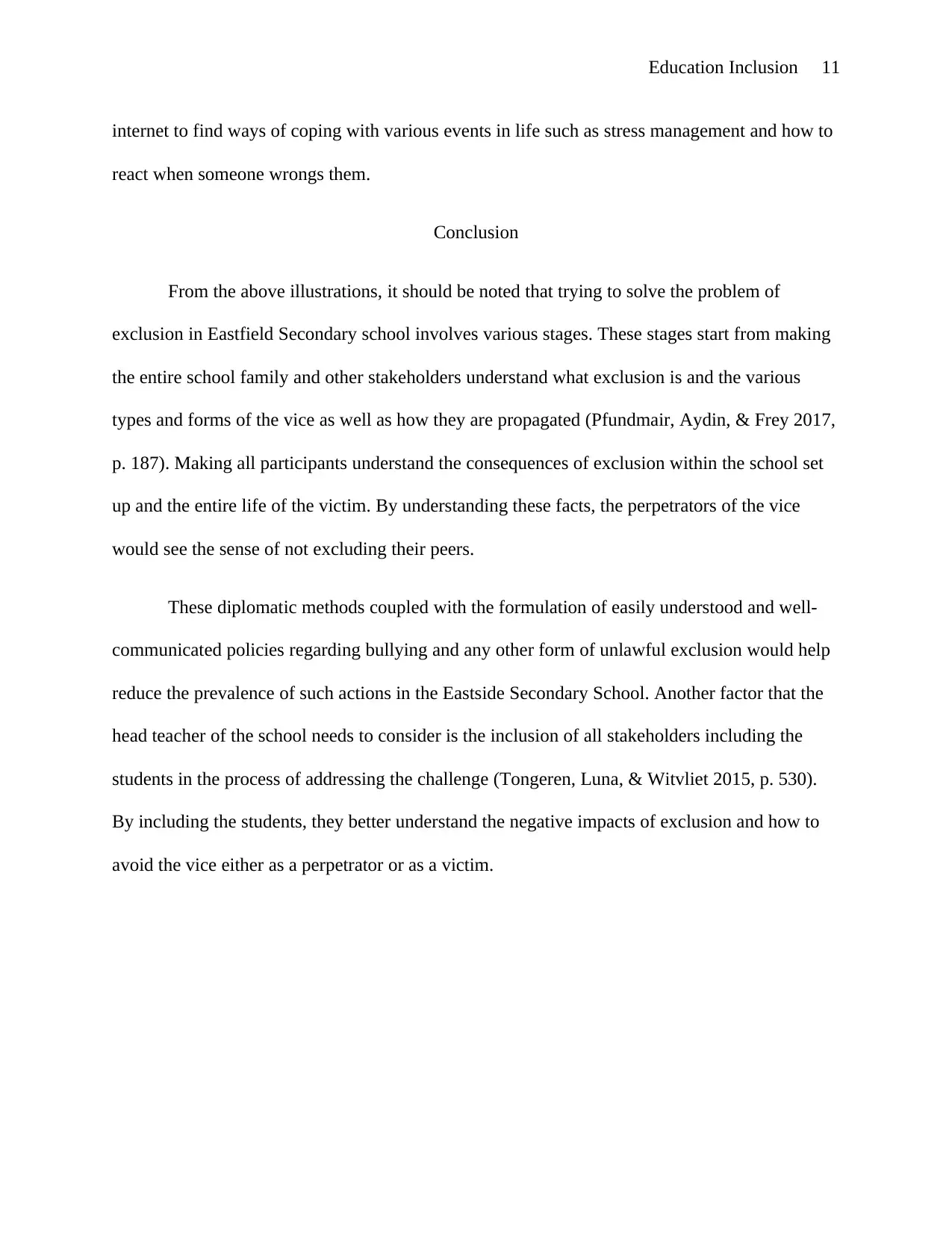
Education Inclusion 11
internet to find ways of coping with various events in life such as stress management and how to
react when someone wrongs them.
Conclusion
From the above illustrations, it should be noted that trying to solve the problem of
exclusion in Eastfield Secondary school involves various stages. These stages start from making
the entire school family and other stakeholders understand what exclusion is and the various
types and forms of the vice as well as how they are propagated (Pfundmair, Aydin, & Frey 2017,
p. 187). Making all participants understand the consequences of exclusion within the school set
up and the entire life of the victim. By understanding these facts, the perpetrators of the vice
would see the sense of not excluding their peers.
These diplomatic methods coupled with the formulation of easily understood and well-
communicated policies regarding bullying and any other form of unlawful exclusion would help
reduce the prevalence of such actions in the Eastside Secondary School. Another factor that the
head teacher of the school needs to consider is the inclusion of all stakeholders including the
students in the process of addressing the challenge (Tongeren, Luna, & Witvliet 2015, p. 530).
By including the students, they better understand the negative impacts of exclusion and how to
avoid the vice either as a perpetrator or as a victim.
internet to find ways of coping with various events in life such as stress management and how to
react when someone wrongs them.
Conclusion
From the above illustrations, it should be noted that trying to solve the problem of
exclusion in Eastfield Secondary school involves various stages. These stages start from making
the entire school family and other stakeholders understand what exclusion is and the various
types and forms of the vice as well as how they are propagated (Pfundmair, Aydin, & Frey 2017,
p. 187). Making all participants understand the consequences of exclusion within the school set
up and the entire life of the victim. By understanding these facts, the perpetrators of the vice
would see the sense of not excluding their peers.
These diplomatic methods coupled with the formulation of easily understood and well-
communicated policies regarding bullying and any other form of unlawful exclusion would help
reduce the prevalence of such actions in the Eastside Secondary School. Another factor that the
head teacher of the school needs to consider is the inclusion of all stakeholders including the
students in the process of addressing the challenge (Tongeren, Luna, & Witvliet 2015, p. 530).
By including the students, they better understand the negative impacts of exclusion and how to
avoid the vice either as a perpetrator or as a victim.
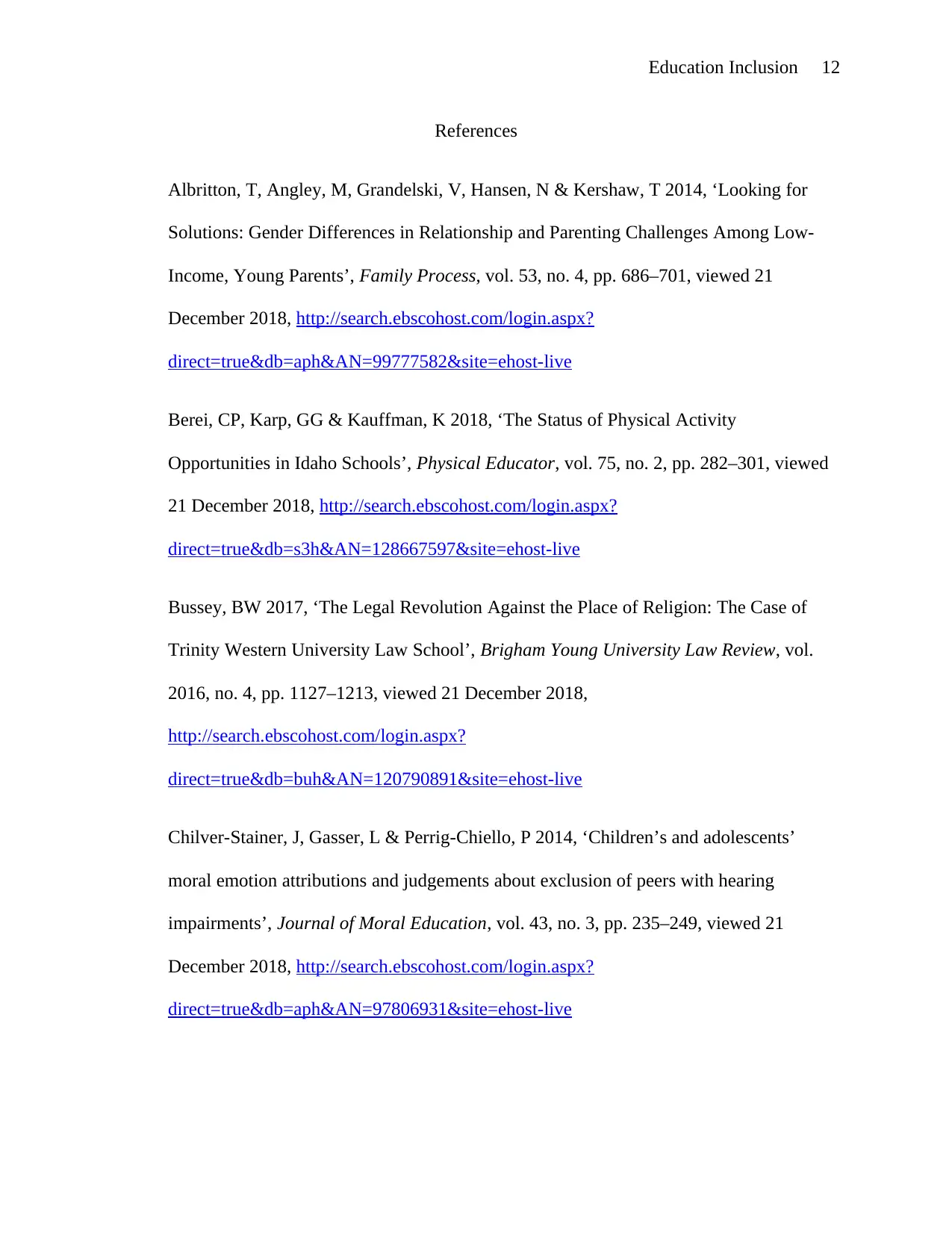
Education Inclusion 12
References
Albritton, T, Angley, M, Grandelski, V, Hansen, N & Kershaw, T 2014, ‘Looking for
Solutions: Gender Differences in Relationship and Parenting Challenges Among Low-
Income, Young Parents’, Family Process, vol. 53, no. 4, pp. 686–701, viewed 21
December 2018, http://search.ebscohost.com/login.aspx?
direct=true&db=aph&AN=99777582&site=ehost-live
Berei, CP, Karp, GG & Kauffman, K 2018, ‘The Status of Physical Activity
Opportunities in Idaho Schools’, Physical Educator, vol. 75, no. 2, pp. 282–301, viewed
21 December 2018, http://search.ebscohost.com/login.aspx?
direct=true&db=s3h&AN=128667597&site=ehost-live
Bussey, BW 2017, ‘The Legal Revolution Against the Place of Religion: The Case of
Trinity Western University Law School’, Brigham Young University Law Review, vol.
2016, no. 4, pp. 1127–1213, viewed 21 December 2018,
http://search.ebscohost.com/login.aspx?
direct=true&db=buh&AN=120790891&site=ehost-live
Chilver-Stainer, J, Gasser, L & Perrig-Chiello, P 2014, ‘Children’s and adolescents’
moral emotion attributions and judgements about exclusion of peers with hearing
impairments’, Journal of Moral Education, vol. 43, no. 3, pp. 235–249, viewed 21
December 2018, http://search.ebscohost.com/login.aspx?
direct=true&db=aph&AN=97806931&site=ehost-live
References
Albritton, T, Angley, M, Grandelski, V, Hansen, N & Kershaw, T 2014, ‘Looking for
Solutions: Gender Differences in Relationship and Parenting Challenges Among Low-
Income, Young Parents’, Family Process, vol. 53, no. 4, pp. 686–701, viewed 21
December 2018, http://search.ebscohost.com/login.aspx?
direct=true&db=aph&AN=99777582&site=ehost-live
Berei, CP, Karp, GG & Kauffman, K 2018, ‘The Status of Physical Activity
Opportunities in Idaho Schools’, Physical Educator, vol. 75, no. 2, pp. 282–301, viewed
21 December 2018, http://search.ebscohost.com/login.aspx?
direct=true&db=s3h&AN=128667597&site=ehost-live
Bussey, BW 2017, ‘The Legal Revolution Against the Place of Religion: The Case of
Trinity Western University Law School’, Brigham Young University Law Review, vol.
2016, no. 4, pp. 1127–1213, viewed 21 December 2018,
http://search.ebscohost.com/login.aspx?
direct=true&db=buh&AN=120790891&site=ehost-live
Chilver-Stainer, J, Gasser, L & Perrig-Chiello, P 2014, ‘Children’s and adolescents’
moral emotion attributions and judgements about exclusion of peers with hearing
impairments’, Journal of Moral Education, vol. 43, no. 3, pp. 235–249, viewed 21
December 2018, http://search.ebscohost.com/login.aspx?
direct=true&db=aph&AN=97806931&site=ehost-live
⊘ This is a preview!⊘
Do you want full access?
Subscribe today to unlock all pages.

Trusted by 1+ million students worldwide
1 out of 17
Related Documents
Your All-in-One AI-Powered Toolkit for Academic Success.
+13062052269
info@desklib.com
Available 24*7 on WhatsApp / Email
![[object Object]](/_next/static/media/star-bottom.7253800d.svg)
Unlock your academic potential
Copyright © 2020–2025 A2Z Services. All Rights Reserved. Developed and managed by ZUCOL.





